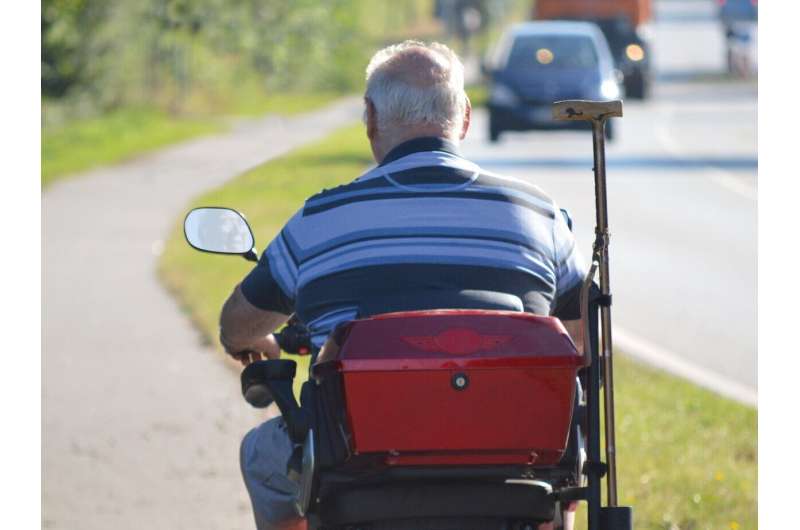
Despite being vulnerable road users, motorized mobility scooter users receive virtually no training about the types of hazards they face that might put them at risk—from designs of road crossings they find difficult to navigate, to obstacles on roads and pavements.
The largest ever study of more than 250 motorized mobility scooter users by Nottingham Trent University (NTU) is the first to highlight and identify a core set of real-world hazards encountered by users and the strategies that users of all experience levels utilize to make their experience safer. The research is published in the journal Accident Analysis & Prevention.
Of those questioned, around 62% had not received any form of training and of the 38% who had, most had received training around vehicle handling. Very few received training about the hazards they would face, with only 8% attending training on an inside course or completing outdoor training or observation.
This is despite findings showing that scooter riders are significantly impacted by the design of roads and crossings which have narrow central areas, difficult to reach buttons, inadequate drop curbs, short crossing times and obstructions that can limit visibility—as well as simply being in complex environments with a mix of pedestrian and road users while having restricted mobility.
As well as facing narrow and bumpy pavements, often with potholes, they also reported regularly encountering difficult to navigate obstacles on the pavement such as parked cars, wheelie bins and shop signs.
Mobility scooter users also found other pedestrians were a significant issue as they were seen to be unpredictable. Many users felt that people are often unaware of when a mobility scooter is nearby and will walk in front of the vehicle. This exacerbated a feeling among the riders of being ignored or treated with hostility by other road users who consider them a nuisance.
With a lack of hazard perception-focused training available users had developed their own strategies, such as focusing on assessing hazardous situations carefully, modifying their speed, waiting until a hazardous situation had passed, being vigilant of their surroundings, ensuring they are visible, learning to position their scooter in particular ways at particular crossings, planning their route in advance, or taking an alternative route. A small number also said they had stopped going out on their mobility scooter at certain times.
Lead researcher from NTU's School of Sciences, Dr. Duncan Guest, said, "The users in our study were very clear that their scooters improved their quality of life, self-esteem, mental well-being and physical health, as well as giving them greater independence. However, there were frustrations over access difficulties and the structure of roads and pavements, which create hazards for both users and others around them.
"Users also felt others had quite negative attitudes towards them. Some of the stigma they face may come from a lack of understanding about the issues that motorized mobility scooter users face and why they behave in a certain way. However, it could also point to inconsistencies in scooter behavior due to a lack of training. Both of these factors may contribute to accidents or close calls.
More information: Duncan Guest et al, Developing a taxonomy of hazards and hazard mitigation strategies for Motorised mobility scooter users, Accident Analysis & Prevention (2023). DOI: 10.1016/j.aap.2023.107423
Citation: Hazard training for mobility scooter users virtually non-existent despite facing regular risks (2024, February 9) retrieved 9 February 2024 from https://techxplore.com/news/2024-02-hazard-mobility-scooter-users-virtually.html
This document is subject to copyright. Apart from any fair dealing for the purpose of private study or research, no part may be reproduced without the written permission. The content is provided for information purposes only.
